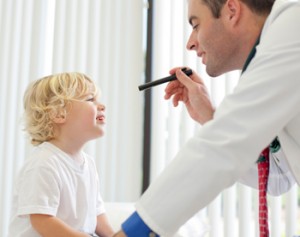A Look into Children’s Eye Development
There may not be a more special moment for new parents than the very first time that their baby looks up, locks eyes with their parent, and smiles. It’s the kind of moment that stays with parents for the rest of their lives, and the kind of moment that they wish and hope that their children are able to experience for themselves when they have children of their own.
If that doesn’t happen right out of the gate – or even within the first week or so of your child’s birth – don’t get nervous and don’t be afraid. Children’s eyes are not fully developed at the time of birth. However, it’s important that you do everything you can to protect them from environmental factors and take steps to spot potential problems that can reduce their vision.
Get a Second Opinion When You Need to
 It’s important to trust your doctors. Your pediatrician will likely provide you with a host of important lessons, tips, and helpful hints to really assist you as new parents in making sure that your children develop just as happy and as healthy as humanly possible. A significant portion of these talks should revolve around protecting and encouraging their eyesight development.
It’s important to trust your doctors. Your pediatrician will likely provide you with a host of important lessons, tips, and helpful hints to really assist you as new parents in making sure that your children develop just as happy and as healthy as humanly possible. A significant portion of these talks should revolve around protecting and encouraging their eyesight development.
However, if you feel at any point that you might want a second opinion, don’t hesitate to get one. Pediatric retinoblastoma is a highly aggressive disease, and every day counts toward getting the right treatment.
Run Through Critical Tests
Almost immediately after your baby is born, the delivery doctor (and later your pediatrician) is going to put your baby through a battery of relatively simple and noninvasive tests. These tests are going to focus on looking for congenital cataracts or more serious eyesight conditions like neonatal eye problems or pediatric retinoblastoma (a very rare but serious type of children’s eye cancer).
Let your doctor run through these tests but make sure that they keep you informed every step of the way, and trust in their ability to develop appropriate action plans to resolve any issues that may arise.
Follow Up with Regular Eye Tests
 Yes, you are going to be exhausted for the first couple of years of your child’s life, but you have to make sure that you don’t miss out on any necessary tests, examinations, or regular checkups. Be sure that development is right on track and that your child’s eyesight and health isn’t at risk.
Yes, you are going to be exhausted for the first couple of years of your child’s life, but you have to make sure that you don’t miss out on any necessary tests, examinations, or regular checkups. Be sure that development is right on track and that your child’s eyesight and health isn’t at risk.
Regular vision checkups (every three months or so at first, and then twice a year until they are two or three is probably a good baseline) will help you to catch serious issues like pediatric retinoblastoma that can move very quickly and aggressively.
Understand Regular Development Milestones
While infants’ eyesight may develop at different rates, there are some milestones that can be used to benchmark normal development:
- Most newborns have peripheral vision
- Focus of up to three feet develops within the first weeks
- By two months, most babies can focus on and track objects
- Distance vision develops by four months old
- Color vision is usually fully developed by about four months old
- Depth perception, focus, and convergence may continue to develop through age seven
If there are any delays in normal vision development or if issues with the eyes are identified, it is important to see a doctor as soon as possible. Spotting issues and eye conditions may help to preserve your child’s vision and potentially his or her life.

















